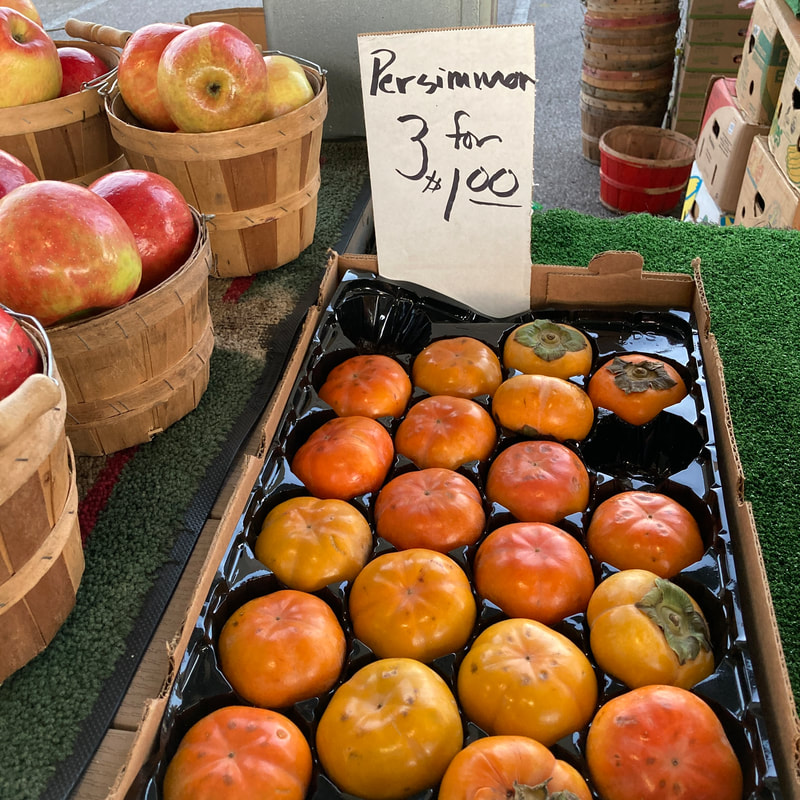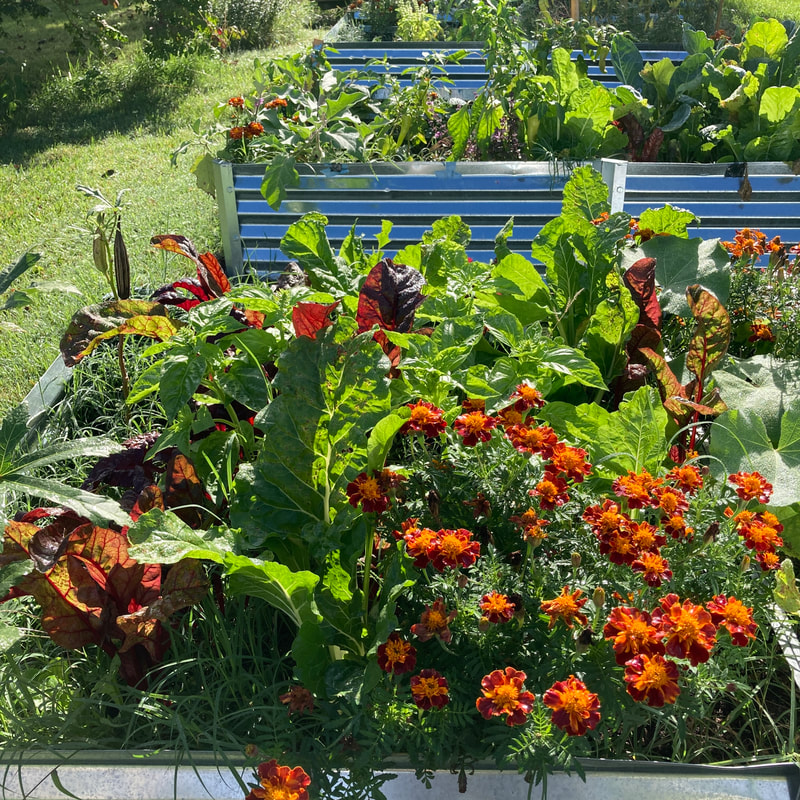|
Photo and article by Donna Iverson
What is a berry not a fruit, looks like an orange donut, and is a favorite of Midwest foragers in late fall? Persimmons. And their popularity is growing, especially in the last year when sales have doubled. Unless you are familiar with persimmons, you may not notice them on the ground when hiking in the woods or at your local farmers market. When I purchased some recently, the farmer smiled and said “someone who knows persimmons.” Actually I didn’t, but was definitely curious. A personal forager friend raved about them, so into my farmers’ market basket they went. Next I had to figure out how to eat one. Basically, there are two types of persimmons….astringent and non astringent. And how you eat them depends on which one is on your plate. You can tell them apart by shape. The astringent ones (which are native) are pear shaped while the non astringent ones look like smushed orange donuts. Mine was definitely donut shaped and thus non astringent. The label said it was imported from California, which produces 10,000 tons of persimmons a year. These California grown persimmons originated in China, where they have been cultivated for thousands of years. The non astringent persimmons are sweeter and can be eaten like an apple, skin and all. Or you can cut them and half and scoop out the pulp like you would an avocado. The jelly-like consistency has a sweet camel taste with a hint of butterscotch. Persimmons can be added to salads, baked into bread and even brewed into tea. Never eat them before they ripen as they can cause digestive problems. As a forager, I was interested in learning more about the native persimmon (Diospyros virginiana). It was first identified in 1880 in Indiana, where an annual persimmon festival is still held in the town of Mitchell every fall. As for Michigan, the persimmon tree will grow as far north as Traverse City and produce fruit but will not ripen because of the short growing season. But that may change as the climate warms. As for the persimmon tree, it grows to a height of 15 feet and looks like a large shrub. It’s wood is used to make billiard cues, bows, wood flutes and in earlier days, wooden golf clubs.
1 Comment
Bat Week, the international celebration of bats, takes place this year Oct. 24-31 and is the perfect time to shine a light on these important species. Michigan is home to nine species of bats, all of which are insectivores. During the evening hours, these flying mammals consume many insect pests including mosquitoes, beetles, moths and flies. The DNR, along with numerous partners, works to conserve bats and bat habitat because many species are in decline. White-nose syndrome is a deadly disease that affects North American bats primarily during their winter hibernation and has devastated many bat species. Infected bats prematurely awaken from hibernation, rapidly deplete their fat reserves and are unable to survive the winter. Bats with this syndrome often exhibit unusual behavior, like flying during daylight hours or gathering outside of caves in cold weather. Learn about our efforts to conserve Michigan's bats in our Wildlife Conservation Month story. Here’s how you can help bats:
Learn more about bats and ways you can take action during Bat Week – and all year long – at BatWeek.org. More information on Michigan's bat species and ways to help is available at Michigan.gov/Bats. Questions? Contact the DNR Wildlife Division at 517-284-9453. Photo and article by Donna Iverson Usually this time of year, I’m cleaning out my garden bed, adding some mulch or compost and wondering how long it will be until the new seed catalogs arrive. But this fall, my garden is still going strong …arugula, parsley, onions, and kale are at their prime. The earliest prediction for first frost isn’t until the end of October. So my fall gardening plans are changing. Instead of pulling out my herbs, flowers and veggies, I plan to let them be. In past winters, I’ve picked arugula and kale well into January and even February. Plus I’m reading that it will benefit the soil leaving the plants to die in place. The roots, especially those of peas and beans, will feed nutrients and nitrogen into the ground. Fall is the time to consider planting a nitrogen-fixing cover crop like hairy vetch or Red clover. Adding a topping of compost or dried leaves to the garden would also be beneficial. Instead of waiting for the new seed catalogs, I am going to dig out my old seed catalogs and order now for fall planting. Following nature’s lead, horticulturists are telling us that it may be better to plant seeds this time of year rather than waiting till spring. Seeds that can be planted in the fall include the veggies that are still growing in late October: arugula, bush beans, broccoli, chard, garlic and onions. Flower seeds that benefit from fall planting are sunflowers, coneflowers, hollyhocks and forget-me-nots. With everything topsy turvy during the last two years, it feels right to rethink gardening strategies along with everything else. And that includes raking leaves. Many a garden ecologist argues that rotting leaves provide fertilizer for the lawn and garden as well as shelter for wildlife. This fall, I will be watching to see how many of my neighbors hang up their garden rakes. Photo and article by Donna Iverson Squirrel corn? Was that a new variety of sweet corn or field corn, I wondered. Then it hit me. Squirrel corn was dried corn being sold at my local farmers market to feed backyard squirrels. At $1 a cob. People were buying it as a treat for squirrels or to provide an alternative feeding station to keep squirrels out of the bird feeders. If that is possible. Which it is not. Of course, DIYers could dry corn themselves and save some money. But it’s a lot of work. First you have to grow the corn and harvest it. Then remove the husks and silks. Next, blanch the corn in boiling water for two minutes to remove bacteria. And then plunge it in ice water. Next, place the cobs on an oven rack on low heat at 175 degrees for 8 to 10 hours. Store in a paper bag. If you live in rural Michigan, you could place the corn on a rack balanced on a couple of saw horses or cement blocks. Place outside in full sun for three to five days and it is ready for use. If you are a farmer, you may have a corn crib to dry corn or a corn drying machine, the cost of which can run up to $100,000. If you plan to feed squirrels with dried corn, remember it is at best a treat and not a nutritional food source. Consider adding apples, watermelon, or cabbage and other vegetables like squash, peas, carrots, and zucchini, to their feeding regime. Of course if you are a wildflower enthusiast. Squirrel corn means something entirely different. It is an early spring native plant that looks a lot like Dutchman’ Breeches. With delicate white flowers it is found in Michigan woodlands. by Annie Nelson
Reviewed by Reference Librarian, Susan Herrick This is so much more than a how-to hiking manual. Nelson writes with candor and a sense of fun. She laughs with joy over a hot shower and makes you shiver with her descriptions of her no longer waterproof rain gear during a rain storm. Included are trail mileage and descriptions, transportation to and from the trail, and how to outsmart critters. A great chapter on cell phone coverage and navigation is included. Trips to Lake Superior north shore are a destination vacation for Midwesterners, and this is your field guide. Every small town bakery between Duluth and the Canadian border is listed, and no out-of-the-way coffee shops are missed. There are lists of wonderful lodges, as well as motels, hostels, and camp grounds, which is nice to know if you’re on the budget tour. You don’t have to be a thru-hiker or a weekend warrior to enjoy this book. If you’d like to check this out from the library, you can place a hold here: https://bit.ly/3uIcSPk |
Archives
July 2024
Categories |





 RSS Feed
RSS Feed